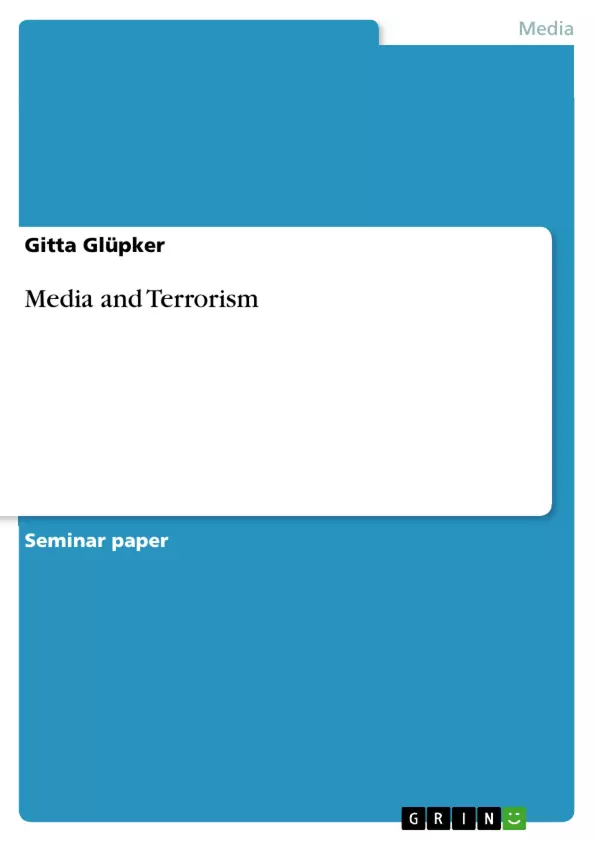Terrorism is an extremely complex phenomenon which can involve a multitude of motives, strategies and actors. Even if terrorism is not an invention of the modern age but it has its roots in the ancient times, the contemporary forms of terrorism display special features. One of them is the “media-oriented terrorism” (Martin 2003: 281). It is linked to the emergence of mass media that allow a global and life coverage of terrorist acts.
This paper will examinate which role the media play for terrorism. How do the media treat the phenomenom of terrorism (chapter 2)? After a brief summary of guidelines of news media the major focus will lie on the coverage of terrorist incidents in reality. As another feature of the media’s perspective the governmental attempts to restrict the freedom of reporting will be described.
The second part of this paper will deal with the media’s role for terrorist strategies (chapter 3). What does media-oriented terrorism mean concretely?
Chapter 5 draws a conclusion from the precedent analysis, after chapter 4 has dealt with the delicate: What are the effects of the media’s involvement in terrorism?
Inhaltsverzeichnis (Table of Contents)
- Introduction
- The Media's Perspective
- The Basics: Professional Standards and News Criteria
- Reporting on Terrorism in Reality: Grey Zones and ‘Painful Decisions’
- The Limits of Journalism: Governmental Regulation
- The Terrorist's Perspective
- The Terrorist's Interest in the Media
- The Adaption to the Media's Criteria
- Media Links and Channels
- The Effects of the Media's Involvement in Terrorism
Zielsetzung und Themenschwerpunkte (Objectives and Key Themes)
This paper examines the role of media in terrorism. It aims to analyze how media portray terrorism, how terrorists utilize media for their strategies, and the consequences of this interplay. The analysis is primarily based on Gus Martin's "Understanding Terrorism."
- The media's portrayal of terrorism and adherence to professional standards.
- The conflict between journalistic ideals and market pressures in covering terrorist events.
- Terrorist exploitation of media for propaganda and strategic purposes.
- Governmental attempts to influence media coverage of terrorism.
- The impact of media involvement on the terrorism phenomenon itself.
Zusammenfassung der Kapitel (Chapter Summaries)
Introduction: This chapter introduces the concept of "media-oriented terrorism" and sets the stage for analyzing the complex relationship between media and terrorism. It highlights the multifaceted nature of terrorism and its evolution in the context of mass media.
The Media's Perspective: This section explores journalistic standards and the practical challenges faced by media outlets in reporting on terrorism. It discusses the inherent conflict between professional ethics and market pressures that often lead to sensationalized coverage. Examples such as Al Qaeda videos and the Abu Sayyaf kidnapping are used to illustrate the “real-time reflex” in news reporting.
The Terrorist's Perspective: This part (partially covered in the provided text excerpt) will likely detail how terrorist groups utilize media to disseminate their messages, recruit members, and achieve their political goals. It will also likely analyze the ways in which they adapt their strategies to effectively engage with media platforms.
The Effects of the Media's Involvement in Terrorism: This chapter will likely discuss the consequences of media's involvement in terrorism, exploring both its positive (increased public awareness, pressure on governments) and negative aspects (propaganda, potential for escalation).
Schlüsselwörter (Keywords)
Media-oriented terrorism, news coverage, journalistic ethics, market pressures, propaganda, governmental regulation, terrorist strategies, media manipulation, Al Qaeda, Abu Sayyaf.
- Quote paper
- B. A. Gitta Glüpker (Author), 2008, Media and Terrorism, Munich, GRIN Verlag, https://www.grin.com/document/124570



